Oakton WD-35634-52 Owner's manual
- Category
- Measuring, testing & control
- Type
- Owner's manual
This manual is also suitable for

pHTestr
®
5 Pocket Testers
Features
• Large easy-to-read LCD with
3-color backlight
• Accuracy of ±0.01 pH ± 1 digit
• 1, 2, or 3 calibration points
• Auto buffer recognition:
US or NIST
• Stability and battery status
icons
• Replaceable single-junction
sensor saves you money
• Auto power-off function
conserves battery life
• IP67 waterproof rating
Operating Manual
Model pH5 — Glass bulb probe for general liquid testing
Model pH5F — Flat probe for surface or micro-volume testing
Model pH5S — Spear-tip probe for testing semisolid and
solid materials
Thank you for purchasing an Oakton
®
pHTestr
®
Pocket pH Tester.
Please carefully read this operating manual before using the product
to obtain an accurate and reliable test result and avoid unnecessary
damage to the tester or
sensor/probe.
the tester is not in use to maintain the sensor’s accuracy. To achieve
maximum accuracy, we recommend soaking the probe in the 3M
KCL storage solution overnight (12 hours) to activate the glass
membrane thoroughly.
Storing the pH5 and pH5F testers dry will NOT cause any permanent
damage. It will only temporarily cause the probe to lose its sensitivity,
which can always be restored by soaking in the storage solution.
Model pH5S: Never store the spear probe in a dry condition because
permanent damage can be caused. The spear probe should always
be stored in the 3M KCL soaking solution (potassium chloride).
One 10-mL bottle of storage solution comes with the tester kit. If the
soaking solution was contaminated, please replace immediately.
pH Calibration
1. Short press /MEAS key to turn on.
2. Rinse the probe in distilled water and use tissue paper
to gently dab off excess water.
3. Pour certain amount (about half volume of the calibration bottles)
of pH 7.00 pH and pH 4.00 buffer solutions in the corresponding
calibration bottles.
4. Long press CAL/ key to enter calibration
mode, short press /MEAS key to return to
measurement mode.
5. Dip the probe in pH 7.00 buffer solution,
stir gently, and allow it to stand still in the
buffer solution until a stable reading is
reached. When measurement stability icon
() appears and remains on the screen
(see Fig 1); then short press CAL/ key to
complete the one-point calibration. The
tester returns to measurement mode and
indication icon “M” will appear at the
bottom left of the screen, indicating the
middle point of calibration has been completed.
6. For 2-point calibration, start with pH 7.00 buffer solution; once
conrmed then rinse the probe in distilled water and dry it with
tissue paper. Dip the probe into pH 4.00 buffer solution, follow the
steps above to complete 2-point calibration. Indication icons “L”
and “M” will appear on the bottom left of the screen.
7. If necessary to perform a 3-point calibration, rinse probe with
water, dip the probe into pH 10.01 buffer solution (sold sepa-
rately), and follow the steps above. Indication icons “L”, “M”,
and “H” will appear on the bottom left of the screen.
Notes
A. Tester can perform 1 to 3 points automatic calibration. Please note
that pH 7.00 (USA Standard) or pH 6.86 buffer solution (NIST Stan-
dard) must be used to conduct 1st point calibration. Then use other
buffer solution to conduct 2nd or 3rd point calibration. Tester will
automatically recognize ve kinds of pH buffer solutions. For details,
please refer to the following table:
Calibration USA series NIST series
Indication
icons
Recommended
1-point 7.00 pH 6.86 pH
M
Accuracy:
≥0.1 pH
2-point
7.00 pH,
4.00 pH or
1.68 pH
6.86 pH,
4.01 pH or
1.68 pH
L M
Range:
<7.00 pH
7.00 pH,
10.01 pH or
12.45 pH
6.86 pH,
9.18 pH or
12.45 pH
M H
Range:
<7.00 pH
3-point
7.00 pH,
4.00 or 1.68 pH,
10.01 or
12.45 pH
6.86 pH,
4.01 or
1.68 pH, 9.18
or 12.45 pH
L M H
Range:
0 to 14.00 pH
B. pH 4.00 and pH 7.00 buffer solutions are included in the pH5S test
kit only but pH 10.01 is not. Users can purchase it separately if
needed. The buffer solutions poured into the calibration bottles
are NOT for one-time use. They can be used multiple times as
long as they are not contaminated, and the bottles are covered
when not in use. After that, we recommend replacing the buffer
solutions in the calibration bottles with new ones that are in the
buffer bottles (50 mL) to keep the accuracy of the standard buffer
solutions. Do not pour used buffer solutions back into the buffer
bottles in case of contamination.
C. The tester has self-diagnostic functions:
Symbol Self-diagnostic information Checking and how to fix
Er 1
Wrong pH buffer solution or
the range of calibration
solution exceeds standard.
1. Check whether pH buffer
solution is correct (1st point
calibration must be 7.00).
2. Check whether the probe is
damaged.
3. Check if there is any air
bubble in the glass bulb
sensor.
Er 2
Press CAL/ key when
reading is not stable during
measurement.
Wait for the measurement
stability icon () to appear and
stay, then press CAL/ key.
* If you nd any air bubble in the glass bulb of the pH sensor, simply invert the
probe for a few times to remove it. The existence of an air bubble in the glass
bulb will signicantly decrease the accuracy of measurement.
* The 1st point calibration must be 7.00 pH. Perform the 2nd point calibration
(4.00 pH) immediately after the 1st point. Do NOT turn off the meter before
you conduct 2nd point calibration. If the meter is turned off after 1st point
calibration, user will need to restart the calibration process with the 7.00 pH
rst and the 4.00 pH following after. Calibrating directly in pH 4.00 after
turning meter off and back on will cause “Er1”.
pH Measurement
1. Short press /MEAS key to turn on the tester. Rinse the probe in
distilled water, and gently dab off excess water with tissue paper
(do not rub or wipe the glass sensor).
2. Dip the probe in sample solution, stir gently, and allow it to stand
until a stable reading is reached. Take readings after stability indi-
cator icon () appears and stays on the screen.
Notes
A. Applications of each model:
Model/Probe Application
pH5/Bulb probe
Regular water solutions’ pH measurement such as
hydroponics, aquaculture, pools and spas, water
treatment, brewing, etc.
pH5F/Flat probe
Flat surface measurement such as skin, paper, fabric,
leather and so on; micro sample testing;
also works well for regular water solution.
pH5S/Spear-tip
probe
Cheese, sushi rice, meat, fruit, bread, soil, solid
culture medium and semisolid medium measurement;
also works well for regular water solution.
B. Model pH5F Flat probe tester is mostly for at surface sample
testing.
• For skin test: skin should be without sweat or dirt, nor be overly
cleaned (do not use facewash products before testing) to avoid
affecting measurement results. Dampen skin with some distilled
water, slightly force at probe onto the skin, get readings after
value stabilized.
• For paper, fabric and leather test: add 1 to 2 drops of distilled water
on surface, then perform measurements.
• For micro sample testing, use a container with an inner diameter
≤19 mm and a at bottom. The tester can test volume ≥0.5 mL.
C. Model pH5S Spear-tip probe tester is widely used for solids
containing water or semisolid medium. When conducting such tests,
pay attention to insert probe evenly and be careful to prevent probe
from damage. If the medium is too hard (such as meat or fruits),
please bore a small hole with a knife before inserting the probe.
For pH measurement of any food (such as meat, cheese, sushi, etc.),
it should be a sampling test. That means test samples should no
longer be edible.
Special Notes
• The pH probe must be rinsed thoroughly after each use. Soap water
should be used to clean off any grease or other contaminants.
• These pH testers will NOT give accurate or stable pH readings
when testing distilled or deionized water. This is because distilled
or deionized water do not have enough ions present for the elec-
trode to function properly. To measure distilled or deionized water’s
pH, users need to use a specialized instrument technique. When
testing puried water like spring water or drinking water, it will take
longer for the readings to get stabilized (typically 3 to 5 minutes)
because there are very few ions left to be detected by the sensor in
those puried water.
• Do NOT store probe in distilled or deionized puried water because
that will cause permanent damage to the pH probe. Puried water
is only recommended for rinsing the probe. The probe should be
stored in 3M KCL pH electrode storage solution (SKU 00653-04) for
best accuracy.
Setting the Parameters
When tester is turned off, long press /MEAS key to enter parame-
ter setting. Short press MODE/ key to switch from P1 to P2…P7.
Short press CAL/ key and parameter will ash, then short press
MODE/ key to choose desired parameter. Short press CAL/ key
to conrm parameter selection. Long press /MEAS key to return
to measurement mode.
Symbol Menu setting Selection
Factory
default
P1 Select pH buffer solution USA – NIST USA
P2 Set low measurement alarm 0 to 14.00 pH 0
P3 Set high measurement alarm 0 to 14.00 pH 14.00
P4 Select Automatic Lock (HOLD) Off – On Off
P5 Select backlight Off – 1 – On 1
P6 Select temperature unit °C – °F °C
P7 Restore to factory default No – Yes No
Notes
A. Select standard pH buffer solution (P1)
There are two options of standard buffer solutions: USA series and
NIST series.
B. High and Low Measurement Heads-Up Examples (P1 and P2)
Alert when measured value ≤3.20 pH: Preset lowest value (P2) =
3.20 pH, highest value (P3) = 14.00 pH, when measured value is
≤3.20 pH (stability icon () displays on LCD), the red backlight
appears on display.
Alert when measured value ≥8.60 pH: Preset highest value (P3)
= 8.60 pH, lowest value (P2) = 0.00 pH, when measured value is
≥8.60 pH (stability icon () displays on LCD), the red backlight
appears on display.
Alert when measured value ≤3.20 pH or ≥8.60 pH: Preset lowest
value (P2) = 3.20 pH, highest value (P3) = 8.60 pH, when mea-
sured value is lower than 3.20 pH or higher than 8.60 pH (stabil-
ity icon () displays on LCD), the red backlight appears on
display.
C. Automatic Lock (P4)
Select “On” to activate auto lock function. When reading is stable for
more than 10 seconds, the tester will lock the value automatically,
and “HOLD” icon will appear on the bottom left of the screen. Press
CAL/ key to cancel HOLD on reading.
D. Backlight (P5)
Select “Off” to turn off backlight function, “On” to turn on backlight
function, or “1” to have backlight last for 1 minute.
E. Temperature Unit (P6)
Select °C or °F; the factory default is °C.
F. Factory Default Setting (P7)
Select “Yes” to recover instrument calibration to the theoretical
value (pH value in zero potential is 7.00 pH, slope is 100%), parame-
ter setting returns to initial value. This function can be used when
instrument does not work properly in calibration or measurement.
Calibrate and measure again after resetting the unit to factory default
status.
ORP Measurement
ORP stands for Oxidation-Reduction Potential. ORP is a measure of
the cleanliness of the water and its ability to break down contami-
nants. Note that ORP sensor module 35634-58 must be purchased
separately (see Ordering Information).
Once ORP sensor probe is attached to tester, press MODE/ key to
enter ORP mode. Rinse the probe in distilled water and dry it. Dip
the probe in sample solution, stir gently, and allow it to stand still
until a stable reading is reached. Get readings after measurement
stability icon () appears and remains on the screen.
6.6
7
pH
pH
☺
☺
Figure 1
Keypad Functions
Short press = <2 seconds Long press = >2 seconds
MEAS
1. Short press to turn on the tester and long press to turn
off the tester.
2. When turned off, long press to enter parameter setting mode.
3. In measurement mode, short press to turn on backlight.
MODE
1. In measurement mode, short press to switch parameter from
pH to ORP (Oxidation Reduction Potential); ORP probe sold
separately.
2. In parameter setting mode, short press to change parameter
(unidirectional).
CAL
<
1. Long press to enter calibration mode.
2. In calibration mode, short press to confirm calibration.
3. When measured value is locked (HOLD icon), short press to
unlock.
Preparation Before Use
Models pH5 and pH5F: If it is rst-time use or the tester hasn’t been
used for a long time, pour some 3M KCL solution to the Fill line in
the probe cap and soak the probe for about 15 to 30 minutes. Users
can store the probe in the 3M KCL solution in the probe cap when
1 2 3
4 5 6

Warranty
We warrant this instrument to be free from defects in material and
workmanship and agrees to repair or replace free of charge, at
option of Oakton Instruments, any malfunctioned or damaged prod-
uct attributable to responsibility of Oakton Instruments, for a period
of two years from the delivery (a six-month limited warranty applies
to sensors). This warranty does not apply to defects resulting from
actions such as misuse (violation of the instructions in this manual
or operations in the manner not specied in this manual), improper
maintenance, and unauthorized repairs. Warranty period is the time
limit to provide free service for the products purchased by custom-
ers, not the service life of the tester or probe.
Oakton Instruments reserves the right to update the
information in this manual without giving notice in advance.
Specifications
pH
Range –2.00 to 16.00 pH
Resolution 0.01 pH
Accuracy ±0.01 pH ±1 digit
Calibration
points
1, 2, or 3 points;
auto buffer recognition
Automatic temperature
compensation (ATC)
32 to 122°F
(0 to 50°C)
ORP (mV)*
Range ±1000 mV
Resolution 1 mV
Accuracy ±0.2% full-scale
Temperature
Range 32 to 122°F (0 to 50°C)
Resolution 0.1°F/°C
Accuracy ±0.9°F (0.5°C)
* Note that the ORP probe 35634-58 must be purchased separately
(see Ordering Information).
Display: LCD with three-color backlight. Blue = measurement;
Green = calibration; Red = alarm
Reading lock: HOLD icon
Power: four AAA batteries (included); >400 hours of continuous
operation
Low-voltage warning: battery status icon ashes
Auto power-off: tester automatically turns off after 8 minutes
of nonuse
IP rating: IP67 (waterproof), oats on water when sensor cap is on
Dimensions (L x W x H):
Models pH5 and pH5F: 7" x 1.5" x 1. 5" (17.8 x 4 x 4 cm)
Model pH5S: 8.5" x 1.5" x 1. 5" (21.6 x 4 x 4 cm)
Weight: 4.7 oz (133 g)
Ordering Information
Model Product description
Catalog
number
pH5 pHTestr 5 pocket pH tester 35634-16
pH5F pHTestr 5F flat-probe pocket pH tester 35634-46
pH5S pHTestr 5S spear-tip pocket pH tester 35634-52
— Replacement probe for pHTestr 5 35634-18
— Replacement flat probe for pHTestr 5F 35634-48
— Replacement spear-tip probe for pHTestr 5S 35634-56
— Optional probe/sensor for ORP testing 35634-58
Probe Replacement
Screw off the probe/sensor ring, unplug the probe, plug in the new
replacement probe (pay attention to the probe’s position), and
rescrew on the sensor ring.
Battery Installation
The tester uses four AAA batteries. Please install batteries according to
the following steps. Note the correct direction of battery installation: the
positive side (+) of every single battery must face up. Incorrect installa-
tion of batteries will cause damage to the tester and create a potential
hazard.
1. Pull the battery cap up.
2. Slide the battery cap along the direction of arrow.
3.③Open the battery cap.
4. Insert the batteries (ALL POSITIVE SIDES FACING UP).
5. Close the battery cap.
6. Slide and lock the battery cap along the direction of arrow.
7. Fit the tester’s cap while making sure to push all the way
down. The tester’s waterproof design may be compromised
if the cap is not tted correctly.
4 x AAA Batteries
+
+
+
+
_
_
_
_
1
2
3
4
5
6
7
1065O101_MAN_pH5_35634-16,-46,-52 March 2018
www.4oakton.com
7 8 9
10 11 12
-
 1
1
-
 2
2
Oakton WD-35634-52 Owner's manual
- Category
- Measuring, testing & control
- Type
- Owner's manual
- This manual is also suitable for
Ask a question and I''ll find the answer in the document
Finding information in a document is now easier with AI
Related papers
-
Oakton pHTestr 10 Waterproof BNC Pocket pH Tester User manual
-
Oakton pHTestr 30 Owner's manual
-
Oakton PCTSTestr 30 pH/Conductivity/TDS/Salinity Waterproof Pocket Tester User manual
-
Oakton ORPTestr Waterproof Pocket ORP Tester User manual
-
Oakton WD-35634-06 Owner's manual
-
Oakton WD-35661-17 Owner's manual
-
Oakton 220 pH/ORP/Temperature Controller, 1/8 DIN User manual
-
Oakton WD-35634-08 Owner's manual
-
Oakton pHTestr 30 User manual
-
Oakton WD-35634-12 Owner's manual
Other documents
-
Basement Watchdog BFB Installation guide
-
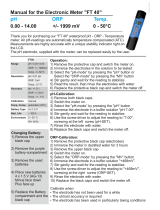 Water I.D. FT 40 User manual
Water I.D. FT 40 User manual
-
EUTECH INSTRUMENTS WATERPROOF PHTESTER 102030BNC User manual
-
Traceable 4277 Owner's manual
-
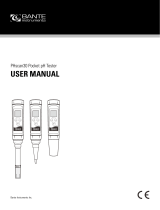 Bante Instruments PHscan30 Pocket pH Tester Owner's manual
Bante Instruments PHscan30 Pocket pH Tester Owner's manual
-
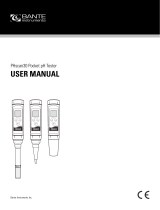 BANTE phscan30 User manual
BANTE phscan30 User manual
-
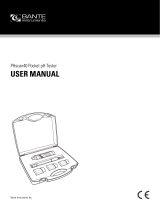 Bante Instruments PHscan40 Pocket pH Tester Owner's manual
Bante Instruments PHscan40 Pocket pH Tester Owner's manual
-
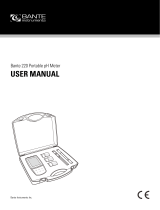 BANTE Bante-220 Portable pH Meter User manual
BANTE Bante-220 Portable pH Meter User manual
-
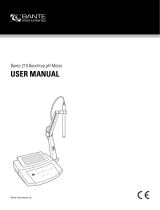 Bante Instruments 210 Benchtop pH Meter Owner's manual
Bante Instruments 210 Benchtop pH Meter Owner's manual
-
Apera PH60S User manual







